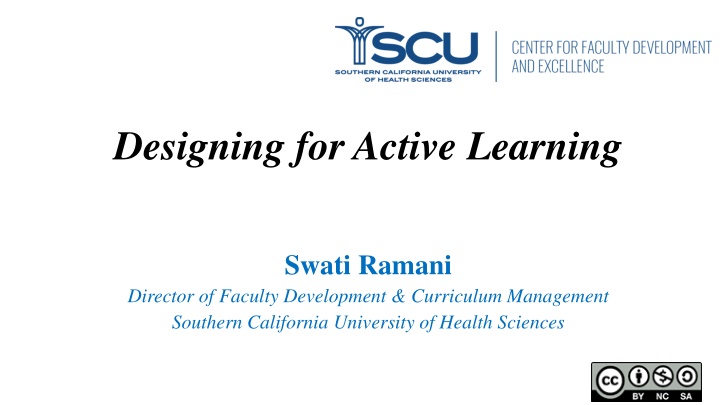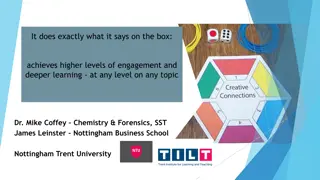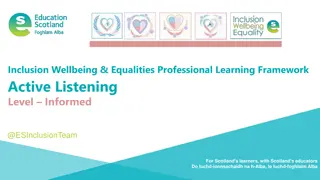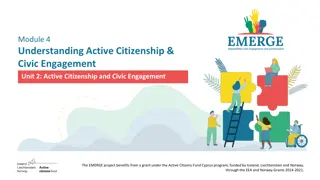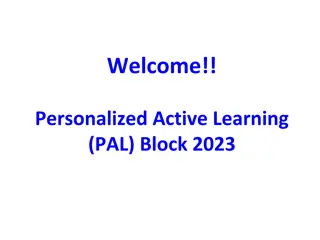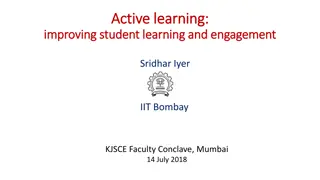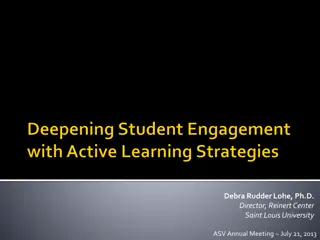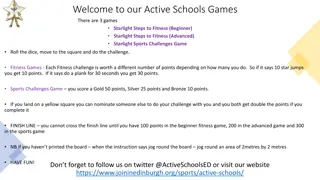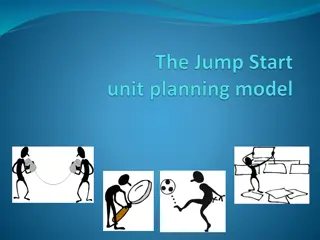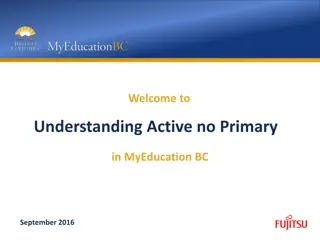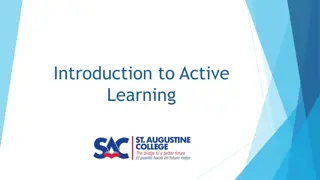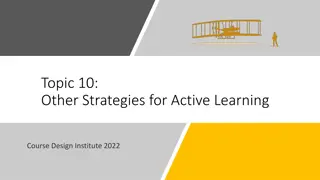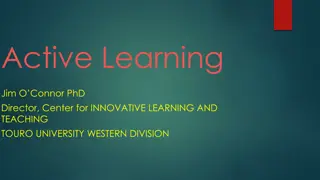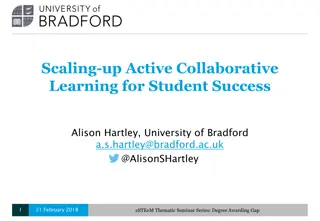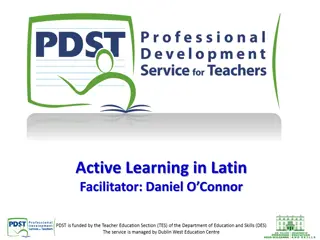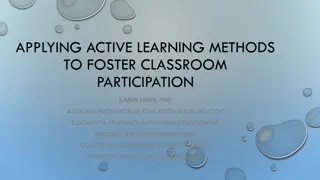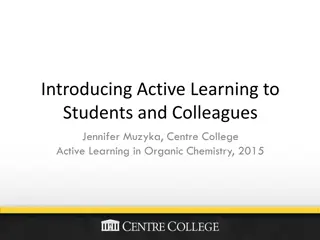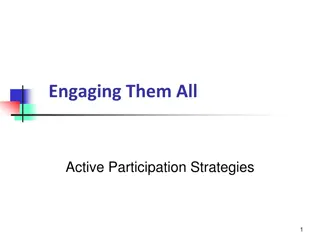Enhancing Learning Through Active Engagement: Strategies and Insights
Explore the concept of active learning with Swati Ramani, Director of Faculty Development & Curriculum Management at the Southern California University of Health Sciences. Discover the practical applications of active learning, key learning outcomes, and strategies for effective implementation. Dive into the dimensions of project repository access, activity outlines, and reflection. Uncover the essence of active learning, where students engage, collaborate, and apply knowledge in real-world contexts. Learn why active learning is essential for student success and how evidence supports its effectiveness in the educational landscape.
Download Presentation

Please find below an Image/Link to download the presentation.
The content on the website is provided AS IS for your information and personal use only. It may not be sold, licensed, or shared on other websites without obtaining consent from the author.If you encounter any issues during the download, it is possible that the publisher has removed the file from their server.
You are allowed to download the files provided on this website for personal or commercial use, subject to the condition that they are used lawfully. All files are the property of their respective owners.
The content on the website is provided AS IS for your information and personal use only. It may not be sold, licensed, or shared on other websites without obtaining consent from the author.
E N D
Presentation Transcript
Designing for Active Learning Swati Ramani Director of Faculty Development & Curriculum Management Southern California University of Health Sciences
Learning Outcomes Clarify an operational definition of active learning Recognize when a course/session design is not fully leveraging an active learning approach Apply active learning pedagogy to your own course/session designs
Agenda Poll Introduction Definitions & Explanations 3 Key Dimensions Access to Project Repository Demo of outlines Activity- Complete one Activity Outline Share your plans on how you are going to use it Reflection Poll
AL Practice 1 (5 min) Let s answer some Poll questions on Zoom
What is Active Learning? Students engage with the material, participate in the class, and collaborate with each other. Don't expect your students simply to listen and memorize Have them demonstrate a process, analyze an argument, or apply a concept to a real-world situation.
What is Active Learning? Any instructional method that engages students in the learning process, which requires students to do meaningful learning activities and think about what they are doing. (Bonwell & Eison, 1991; Chickering & Gamson, 1987, 1999; Chickering & Ehrmann, 1996; Michael, 2006; Niemi, 2002; Prince, 2004; Sivan, Leung, Woon, & Kember, 2000)
What is Active Learning? They are goal-oriented and DOING something concrete Any instructional method that engages students in the learning process, which requires students to do meaningful learning activities and think aboutwhat they are doing. Relevant and connected to their lives and identities Metacognition- thinking about their thinking and learning (Bonwell & Eison, 1991; Chickering & Gamson, 1987, 1999; Chickering & Ehrmann, 1996; Michael, 2006; Niemi, 2002; Prince, 2004; Sivan, Leung, Woon, & Kember, 2000)
Why Active Learning? Evidence! Evidence! Evidence!............Literature Samples The literature is positive about the effects of active learning According to Prince (2004), Introducing active learning strategies into the lecture likely aligns the lecture to the optimal attention span for students. Ruhl et al. (1987) is a study about the effects of pause procedure during the lecture. The pause procedure is a simple procedure to help improve effectiveness of lectures Forsyth (2016) encourages faculty to use student-centered teaching methods, provide feedback, provide an orderly learning environment, use technology effectively, self-evaluate and document student success. Barkley (2009) provides a conceptual framework for understanding the importance of student engagement while teaching. Persky s (2012) study focused on immediate authentic application and assessed the impact of team-based learning (TBL) in a foundational pharmacokinetics course and reported increased student learning outcomes and team learning skills. Touchton s (2015) work examined immediate feedback and assistance in a flipped classroom and reported an increase in students learning and application of problem-solving skills. Becker s (2013) examined self-regulated learning interventions for an accounting course and reported increased learning outcomes along with improved metacognitive skills among students . ... (Prince, 2004; Ambrose, Bridges, Lovett, DiPietro, & Norman, 2010; Angelo & Cross; 1993; Bain, 2004; Barkley, 2009; Brookfield, 2006; Chickering & Gamson, 1987; Davis, 2009; Nilson, 2010; Gyorko et al., 2016; Forsyth, 2016; Bonwell & Eison, 1991; Michael, 2006; Persky s, 2012; Touchton, 2015; Becker s, 2013; Ruhl et al., 1987 )
When can you use Active Learning? Active learning can be used in traditional classrooms fully online sessions (synchronous or asynchronous) blended classrooms technical & procedural training pretty much anytime someone needs to learn something
How can we identify Active Learning? The 3 key dimensions identified through reviewing the literature that should be accommodating/integrating into course/session design are (Bradford, 2018): 1. Engagement or Participation (Department of Defense (DOD), 2001; Hirumi, A., 2006; Hrastinski, S., 2008a, 2008b, 2009/1) 2. (Perceived) Meaningfulness of Instructional Activity 3. Reflection (Metacognitive) (Bransford, Brown, Cocking, 1999; Sternberg, 1985; Zimmerman and Schunk, 1998; as well as Boekaerts, Pintrich, and Zeidner, 2000; Brown, Bransford, Ferrara, and Campione, 1983; Pintrich, Wolters, and Baxter, 2000; Anderson, Krathwohl, et al., 2001) Bandura, A, 1977; Bransford, Brown, & Cocking, 2000; Hull, C, 1943; Jonassen, D, 1999; Keller, J, 1983, 1987a, 1987b, 1999, 2006; Keller, J & Suzuki, K, 2004; Kim, C & Keller, J, 2008; Maslow, A, 1954; Mayer, R, 2004; McClelland, D, Atkinson, J, Clark, R & Lowell, E, 1953; Murray, H, 1943; Reigeluth, C & Moore, J, 1999; Rotter, 1954; Seligman, M, 1975; Vygotsky, L, 1978; see Kozulin, A., Gindis, B., Ageyev, V. S., & Miller, S. M., 2003 (pp 251-252); Weiner, B, 1974, 1979
Active Learning General Outline* Preparatory Assessment (8 min) Poll A / Poll B / Introduction (5 min) Unit / Topic/ Learning Context and Lesson Introduction Common Confusions / Explanations (5 min) Discussion Activity #1: (Competency Topic general treatment of concepts, theories, procedures, algorithms) (20 min) Introduction / Breakout instructions / Breakouts Debrief / Activity Summary Activity #2: (Working Competency in Context practice using concepts, theories, procedures, algorithms) (32 min) Introduction / Breakout instructions / Breakouts / Debrief Wrap-up (10 min) Reflection Poll / Session Summary / What s next 80 minutes session * There may be outside class pre-work assigned before coming into this session
AL Practice 2: Access to Project Repository (5 min) Access to Project Repository: https://tinyurl.com/activelearningqmconnect
AL Practice 3: Complete/Create an AL outline (10 min) Please complete an Active Learning Activity Outline provided to you based on what you plan to teach. 1. Fill in an incomplete outline here: https://tinyurl.com/incompletealoutline Create your own design here: https://tinyurl.com/createaloutline 2.
AL Practice 4: Debrief (5 min) 1. What are the key take ways for the previous activity? 2. Share your plans with us on how you are going to use it.
AL Practice 5: Share Plans/Join us! (2 min) 1. Submit to the repository link. Help us add to this repository
AL Practice 6: Wrap-up/Reflection Poll (3-5 minutes) Write onesentence of what active learning you can apply in your teaching Write one question you still have about Active Learning Link: https://tinyurl.com/QMALReflect 1. 2.
Contact Email: swatiramani@scuhs.edu Center for Faculty Development & Excellence (CFDE) Southern California University of Health Sciences 16200 Amber Valley Drive, Whittier, CA 90604
References Ambrose, S. A., Bridges, M. W., DiPietro, M., Lovett, M. C., & Norman, M. K. (2010). How learning works: Seven research-based principles for smart teaching. San Francisco, CA: Jossey-Bass. Anderson, L.W., Krathwohl, D.R. & Bloom, B. S. (2001). A taxonomy for learning, teaching, and assessing: a revision of Bloom's taxonomy of educational objectives. Longman. Angelo, T. A., & Cross, P. K. (1993). Classroom assessment techniques: A handbook for college teachers (2nd ed.). San Francisco, CA: Jossey-Bass. Bain, K. (2004). What the best college teachers do. Cambridge, MA: Harvard University Press. Bandura, A. (1977a). Self-efficacy: Toward a unifying theory of behavioral change. Psychological Review, 84(2), 191-215. Barkley, E. F. (2009). Student engagement techniques: A handbook for college faculty. San Francisco, CA: Jossey-Bass. Becker, L. L. (2013). Self-regulated learning interventions in the introductory accounting course: An empirical study. Issues in Accounting Education, 28(3), 435-460. https://doi.org/10.2308/iace-50444 Biggs, J. (1996). Enhancing teaching through constructive alignment. Higher Education, 32(3), 347-364. doi:10.1007/bf00138871 Bonwell, C. C., & Eison, J. A. (1991). Active Learning: Creating Excitement in the Classroom. 1991 ASHE-ERIC Higher Education Reports. ERIC Clearinghouse on Higher Education, The George Washington University, One Dupont Circle, Suite 630, Washington, DC 20036-1183. Bradford, G. (2018). Unpublished Paper. Active Learning. Keck Graduate Institute. Bransford, J. D., Brown, A. L., & Cocking, R. R. (2000). How people learn (Expanded ed.). Washington, DC: National Academy. Brookfield, S. D. (2006). The skillful teacher: On technique, trust, and responsiveness in the classroom (2nd ed.). San Francisco, CA: Jossey-Bass. Clark, R. C., & Mayer, R. E. (2008). E-learning and the science of instruction: Proven guidelines for consumers and designers of multimedia learning. San Francisco: Pfeiffer. Chickering, A. W., & Gamson, Z. F. (1987). Seven principles for good practice in undergraduate education. AAHE bulletin, 3, 7. Chickering, A. W., & Gamson, Z. F. (1999). Development and adaptations of the seven principles for good practice in undergraduate education. New directions for teaching and learning, 1999(80), 75-81. Chickering, A. W., & Ehrmann, S. C. (1996). Implementing the seven principles: Technology as lever. AAHE bulletin, 49, 3-6. Department of Defense Handbook - Development of interactive multimedia instruction (IMI) (Part 3 of 5 Parts). (2001). Department of Defense (DoD). Davis, B. G. (2009). Tools for teaching (2nd ed.). San Francisco, CA: Jossey-Bass. Dunwill, E. (2017). 6 Teaching Principles Transferred To Online Courses: Strategies To Use. Retrieved March 11, 2018, from https://elearningindustry.com/6-teaching-principles-transferred-online-courses-strategies-use Gyorko, J., MacCormack, P., Bless, M., & Jodl, J. (2016, November). Why Colleges and Universities Need to Invest in Quality Teaching More Than Ever. Retrieved July 5, 2018, from http://acue.org/quality-teaching/ Forsyth, D. R. (2016). College teaching: Practical insights from the science of teaching and learning. Washington, DC: American Psychological Association. Fink, L. D. (2013). Creating significant learning experiences, revised and updated: An Integrated Approach to Designing College Courses. San Francisco: Jossey-Bass. Hirumi, A. (2006). Analysing and designing e-learning interactions. In C. Juwah (Ed.), Interactions in online education: Implications for theory and practice (pp. 46 71). 270 Madison Ave, New York, NY 10016: Routledge Taylor & Francis Group. Horii, C. V. (2013). E110. Principles of university teaching in STEM [Syllabus]. Center for Teaching, Learning, & Outreach, California Institute of Technology, Pasadena, CA. Retrieved from https://www.teachlearn.caltech.edu/documents/15-e110_syllabus_as_of_9- 30-2013.pdf Hrastinski, S. (2008). What is online learner participation? A literature review. Computers & Education, 51(4), 1755 1765. Hrastinski, S. (2009/1). A theory of online learning as online participation. Computers & Education, 52(1), 78 82. Hrastinski, S. (2008). The potential of synchronous communication to enhance participation in online discussions: A case study of two e-learning courses. Information & Management, 45(7), 499 506. Hull, C. L. (1943). Principles of behavior: An introduction to behavior theory. New York, NY: D. Appleton-Century Company, Inc. Jonassen, D. H. (1999). Designing constructivist learning environments. Instructional Design Theories and Models: A New Paradigm of Instructional Theory, 2, 215 239. Keller, J., & Suzuki, K. (2004). Learner motivation and e-learning design: A multinationally validated process. Learning, Media and Technology, 29(3), 229-239. Keller, J. M. (1987a). Strategies for stimulating the motivation to learn. Performance and Instruction, 26(8), 1-7. Keller, J. M. (1987b). The systematic process of motivational design. Performance and Instruction, 26(9), 1-8. Keller, J. M. (2006). What is motivational design? Retrieved from http://www.arcsmodel.com/pdf/Motivational%20Design%20Rev%20060620.pdf Kim, C., & Keller, J. M. (2008). Effects of motivational and volitional email messages (MVEM) with personal messages on undergraduate students motivation, study habits and achievement. British Journal of Educational Technology, 39(1), 36-51. doi:10.1111/j.1467-8535.2007.00701.x Maslow, A. H. (1954). Motivation and personality. New York, NY: Harper & Row. Mayer, R. E. (2004). Should there be a three-strikes rule against pure discovery learning? The American Psychologist, 59(1), 14. McClelland, D. C., Atkinson, J. W., Clark, R. A., & Lowell, E. L. (1953). The achievement motive. New York, NY: Appleton-Century-Crofts. Moreno, R., & Mayer, R. E. (2000). Engaging students in active learning: The case for personalized multimedia messages. Journal of Educational Psychology, 92(4), 724 733. Michael, J. (2006). Where's the evidence that active learning works?. Advances in physiology education, 30(4), 159-167. Murray, H. A. (1940). What should psychologists do about psychoanalysis. Journal of Abnormal and Social Psychology, 35(2), 150-175. Niemi, H. (2002). Active learning a cultural change needed in teacher education and schools. Teaching and teacher education, 18(7), 763-780. Nilson, L. B. (2010). Teaching at its best: A research-based resource for college instructors (3rd ed.). San Francisco, CA: Jossey-Bass. Persky, A. M. (2012). The impact of team-based learning on a foundational pharmacokinetics course. American Journal of Pharmaceutical Education, 76(2), 31. Preparing Future Faculty (2018). Claremont Graduate University. http://mycampus.cgu.edu/web/preparing-future-faculty Prince, M. (2004). Does active learning work? A review of the research. Journal of engineering education, 93(3), 223-231. Reigeluth, C. M., & Moore, J. (1999). Cognitive education and the cognitive domain. Instructional-Design Theories and Models: A New Paradigm of Instructional Theory, 2, 51 68. Riggs, S., & Linder, K. (2016, December). Actively Engaging Students in Asynchronous Online Classes. Retrieved July 13, 2018, from https://www.ideaedu.org/Portals/0/Uploads/Documents/IDEA Papers/IDEA Papers/PaperIDEA_64.pdf Rotter, J. B. (1954). Social learning theory and clinical psychology. New York, NY: Prentice-Hall. Ruhl, K., C. Hughes, and P. Schloss. (1987). Using the Pause Procedure to Enhance Lecture Recall, Teacher Education and Special Education, Vol.10, Winter, pp. 14 18. Ryan, R. M., & Deci, E. L. (2000). Self-determination theory and the facilitation of intrinsic motivation, social development, and well-being. American Psychologist, 55, 68-78 Seligman, M. E. P. (1975). Helplessness. San Francisco, CA: Freeman. Sivan, A., Leung, R. W., Woon, C. C., & Kember, D. (2000). An implementation of active learning and its effect on the quality of student learning. Innovations in Education and Teaching International, 37(4), 381-389. Touchton, M. (2015). Flipping the classroom and student performance in advanced statistics: Evidence from a quasi-experiment. Journal of Political Science Education, 11(1), 28-44. https://doi.org/10.1080/15512169.2014.985105 Weiner, B. (1979). A theory of motivation for some classroom experiences. Journal of Educational Psychology, 71(1), 3-25. doi:10.1037/0022-0663.71.1.3 Weiner, B. (1974). Achievement motivation and attribution theory. Morristown, N.J.: General Learning Press. Wiggins, G. P., & McTighe, J. (2008). Understanding by design. Alexandria, VA: Association for Supervision and Curriculum Development. Vygotsky, L Zone of proximal development (see pp 251-252: Kozulin, A., Gindis, B., Ageyev, V. S., & Miller, S. M. (2003). Vygotsky s Educational Theory in Cultural Context. Cambridge University Press.) Vygotsky, L. S. (1978). Interaction between learning and development. In M, Cole, V. John-Steiner, S. Scribner, & E. Souberman (Eds.), Mind in society. The development of higher psychological processes (pp. 79-91), Cambridge, MA: Harvard University Press.
